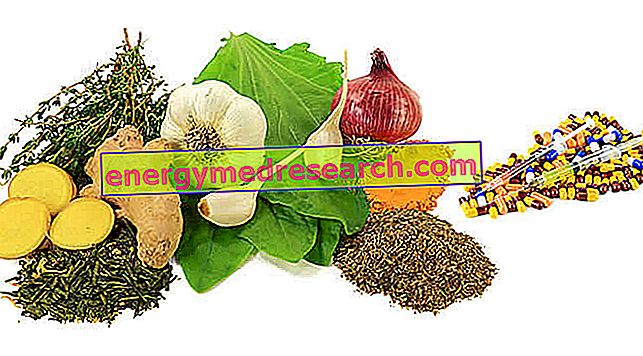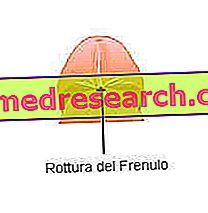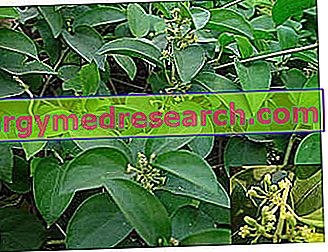Generally, the term "natural antibiotics" refers to those substances with antibacterial activity derived from plants.
In fact, antibiotics of natural origin do not only come from plants, but also from fungi, bacteria and animals.

Antibiotics are substances used to fight bacterial infections and can have a bacteriostatic action (ie they inhibit bacterial growth) or bactericide (ie they are able to kill bacteria).
Antibiotics produced by mycetes
The kingdom of mycetes - better known as the kingdom of fungi - includes many organisms, from the smallest and simplest ones (such as yeasts and molds) to the most complex and large ones (such as the mushrooms that are part of our diet).
The main natural antibiotics produced by mycetes are listed below.
penicillins
The first penicillin - penicillin G - was discovered by Alexander Fleming in 1929 and became the forefather of the great penicillin family.
Penicillin G is a product of the metabolism of the fungus Penicillium notatum (now known as Penicillium chrysogenum ).
During his studies, Fleming noted that a bacterial culture plate was contaminated with a mold and that within that same plate the growth of the bacteria was strongly inhibited. Subsequent studies that were carried out led to the identification and isolation of penicillin G.
From that moment on, research in this field received a great boost, leading to the synthesis of new penicillins with improved characteristics.
Penicillins are bactericidal antibiotics.
Benzylpenicillin, oxacillin, cloxacillin, nafcillin, ampicillin, amoxicillin, bacampicillin and carbenicillin are part of this class of drugs.
Cephalosporins
The discovery of the first cephalosporin - cephalosporin C - occurred in Italy thanks to the doctor Giuseppe Brotzu.
Cephalosporin C is derived from the fungus Cephalosporium acremonium (now known as Acremonium chrysogenum ) and is the progenitor of the cephalosporin family.
Cephalosporins are bactericidal antibiotics.
This category includes cefapirina, cefalexin, cefuroxime, cefotetan, cefaclor, cefixime and ceftibuten.
Antibiotics produced by bacteria
Some antibiotics of natural origin have been isolated from bacterial cultures, in particular from actinomycetes (Gram-positive bacteria). Below are the classes of drugs that originate precisely from bacteria.
carbapenems
Carbapenemes are bacteriostatic antibiotics. The progenitor of this class of drugs is thienamycin, which was isolated for the first time from actinomycete Streptomyces cattleya .
Imipenem and meropenem are part of this category.
Tetracycline
Tetracyclines are a set of bacteriostatic compounds obtained from actinomycete bacteria belonging to the genus Streptomyces . In particular, the first tetracycline to be discovered - chlortetracycline - was obtained from cultures of Streptomyces aureofaciens.
This family includes tetracycline, demeclocicline, oxytetracycline, minocycline and doxycycline.
Aminoglycoside antibiotics
Aminoglycoside antibiotics are bactericidal compounds. Streptomycin (the progenitor) was discovered by biologist Selman Abraham Waksman in 1952, who isolated it from cultures of the actinomycete Streptomyces griseus .
Neomycin, kanamycin and gentamicin are part of this family of drugs.
Macrolides
Macrolide antibiotics can have both bacteriostatic and bactericidal activity, depending on the concentration of the drug and depending on the microorganism to be contrasted.
The forefather of this family of antibiotics is erythromycin, obtained from cultures of Streptomyces erythraeus .
Clarithromycin and azithromycin also belong to this family.
Chloramphenicol
Chloramphenicol is a bacteriostatic antibiotic that can become bactericidal at very high concentrations.
It was first isolated from bacterial cultures of Streptomyces venezuelae .
Vancomycin
Vancomycin is an antibiotic obtained by fermentation of the bacterium Amicolatopsis orientalis .
daptomycin
Daptomycin is a bactericidal antibiotic obtained from the bacterium Streptomyces roseosporus .
Antibiotics produced by the human body
The ability to synthesize antibiotic substances belongs to almost all living beings, including humans.
The white blood cells of the human body produce certain substances with an antimicrobial action, including defensins and catelicidins .
The destruction of pathogens by the human immune system is entrusted mainly to some leukocytes (white blood cells), in particular, to macrophages, neutrophils and cytotoxic T lymphocytes. These cells are able to ingest and digest pathogens by secreting strong oxidizing substances. Numerous enzymes also contribute to this action, such as lactoferrin, lysozyme, collagenase and elastase.
Then there are peptides with antimicrobial action, such as defensins and catelicidins and the protein inducing bacterial permeability.
Defensins and catelicidins are an integral part of the innate (non-specific) immune system; they belong to the class of antimicrobial peptides ( AMPS ) and have a broad-spectrum antimicrobial action. In fact, they are active above all against Gram-positive and Gram-negative bacteria, but they also have a certain antiviral, antifungal, antiparasitic and antitumor activity.
In addition to direct antimicrobial activity - generally performed by creating pores in the bacterial membrane - defensins and catelicidins are able to enhance the immune response by stimulating the intervention of leukocytes.
Defensins and catelicidins are crammed inside the neutrophil granules: defensins are found inside the primary granules, while the catelicidins are found in the secondary granules.
Antibiotics produced by plants
Some types of plants are able to produce antibacterial substances, even if they have a much lower activity than that possessed by antibiotics deriving from fungi and bacteria.
Moreover, it is good to remember that the antibacterial substances contained in these plants can interfere with any pharmacological treatments already in place.
Plants also contain other compounds that could be potentially dangerous to the individual.
Therefore, before using herbal or homeopathic remedies, it is good to consult your doctor and ask your pharmacist for advice.
Garlic (Allium sativum)
Inside the garlic is contained a particular substance - allicin - which has antibacterial properties. Furthermore, allicin also has antifungal, antiviral, anti-inflammatory and analgesic properties.
The use of garlic in folk medicine is very ancient and documented, especially as regards the treatment of infections and the prevention of atherosclerosis and hypertension.
Cinnamon (Cinnamomum zeylanicum)
Cinnamon has antimicrobial and eupeptic properties (facilitates digestion).
It was once used for the treatment of gastrointestinal pathologies, bacterial cystitis, vaginitis and oral infections.
Onion (Allium cepa)
The onion contains sulfur substances with antibiotic properties. Moreover, it also has anti-inflammatory activity and seems useful in the prevention of atherosclerosis.
Echinacea (Echinacea)
Echinacea, in reality, does not produce a true substance with antibacterial action, but has adaptogenic and immunostimulant properties that make it useful in the adjuvant treatment of respiratory and lower urinary tract infections.
Eucalyptus (Eucalyptus globulus)
The essence of eucalyptus - in addition to boasting mucolytic and expectorant properties - also has antibacterial properties. Therefore, it can be useful as an antiseptic in case of pharyngitis, bronchitis, ear infections and adenites.
Idraste (Hydrastis canadensis)
Moisture contains a substance called berberine. This substance has antibacterial properties and can also be useful in the treatment of recurrences from Candida albicans .
Propolis
Propolis is a resinous material that is produced by bees following the elaboration of the waxy-rubbery substances that cover the flower buds.
Propolis is used by bees to cement the cells of the hive. It is used thanks to its bacteriostatic, bactericidal, antifungal and antiviral properties
Essential oils
Essential oils (or essences, or volatile oils) consist of a mixture of highly volatile substances and are characterized by an intense smell. For this reason, the components of essential oils are also called "aromatic".
Essential oils can be made up of variable mixtures of substances, such as terpenes, alcohols, aldehydes, ketones and esters.
Essential oils extracted from some types of plants have antibacterial properties. Among these plants, we recall:
- Thyme ( Thymus vulgaris );
- The lemon ( Citrus limon );
- The oregano ( Origanum vulgare );
- Peppermint ( Mint x piperita );
- Rosemary ( Rosmarinus officinalis ).



